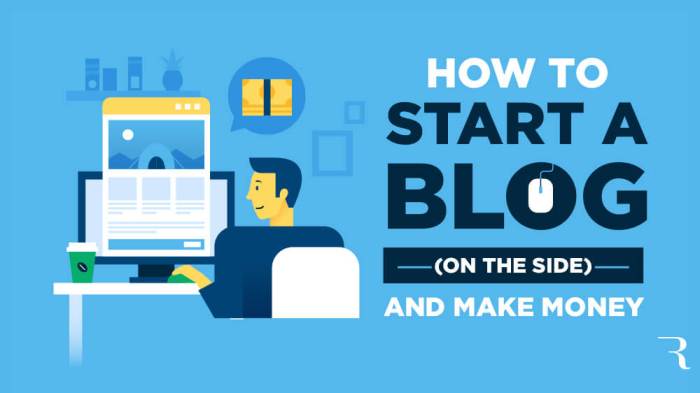How to Start a Blog takes center stage in the digital realm, where creativity meets strategy. Dive into the world of blogging with this complete guide tailored for aspiring content creators.
Are you ready to embark on this exciting journey? Let’s get started!
Introduction to Blogging
A blog is a digital platform where individuals or groups can share their thoughts, ideas, experiences, and expertise on a particular subject. It serves as an online journal or informational website that is regularly updated with new content. The purpose of a blog is to connect with an audience, express oneself, educate others, or even make money through various monetization strategies.
Benefits of Starting a Blog
- Build an Online Presence: Having a blog allows you to establish yourself as an authority in your niche and build credibility.
- Connect with Like-minded People: Through a blog, you can connect with people who share similar interests and engage in meaningful discussions.
- Monetization Opportunities: Successful bloggers can earn money through various avenues such as affiliate marketing, sponsored content, and selling digital products.
Examples of Successful Blogs and Their Impact
1. The Huffington Post: Started as a political blog, it has grown into one of the most popular news and opinion websites, reaching millions of readers worldwide.
2. The Blonde Salad: A fashion blog created by Chiara Ferragni that has evolved into a multi-million dollar business with collaborations with major fashion brands.
3. TechCrunch: A blog focused on technology news and analysis, it has become a go-to source for industry updates and has influenced the tech startup ecosystem.
Identifying Your Niche
When starting a blog, choosing the right niche is crucial for your success in the blogging world. Your niche is essentially the specific topic or subject that your blog will focus on. It’s important to select a niche that you are passionate about and have knowledge of, as this will keep you motivated and engaged in creating content. Here are some tips on how to identify the perfect niche for your blog:
Choosing a Niche You’re Passionate About
Finding a niche that you are genuinely interested in is key to sustaining your motivation and creativity in the long run. Consider your hobbies, interests, and expertise when selecting a niche for your blog. Your passion will shine through in your content and resonate with your audience.
Researching and Validating Your Chosen Niche
Before finalizing your niche, it’s essential to research and validate its potential. Look into the demand for content in your chosen niche, the competition you will face, and the target audience you will be catering to. Conduct research, analyze trends, and identify gaps in the market that you can fill with your unique perspective.
Setting Up Your Blog

To start your blog, you need to choose a blogging platform, select a domain name, and get a hosting service. Let’s dive into the details below.
Choosing a Blogging Platform
When it comes to choosing a blogging platform, you have several options to consider. Some popular platforms include WordPress, Blogger, and Wix. Each platform has its own set of features and benefits, so it’s essential to choose one that aligns with your blogging goals and technical skills.
- WordPress: Known for its flexibility and customization options, WordPress is a popular choice for both beginners and experienced bloggers. It offers a wide range of themes and plugins to enhance your blog’s functionality.
- Blogger: Owned by Google, Blogger is a user-friendly platform that is perfect for beginners. It’s easy to set up and use, but it may not offer as many customization options as WordPress.
- Wix: Wix is a website builder that also offers blogging capabilities. It’s known for its drag-and-drop interface, making it easy to create a visually appealing blog without any coding knowledge.
Selecting a Domain Name and Hosting Service
Your domain name is your blog’s web address, so it’s essential to choose one that is memorable and reflects your blog’s content. When selecting a domain name, make sure it is relevant to your niche and easy to spell.
Pro Tip: Avoid using numbers or hyphens in your domain name, as they can make it harder for users to remember.
Once you have chosen a domain name, you’ll need to select a hosting service to make your blog accessible on the internet. Hosting services store your blog’s files and make them available online. Consider factors like uptime, customer support, and pricing when choosing a hosting provider.
Designing Your Blog
When it comes to designing your blog, there are several essential elements to consider in order to create a visually appealing and user-friendly layout. In today’s digital age, having a responsive design that caters to mobile users is also crucial for reaching a wider audience and providing a seamless browsing experience.
Essential Elements of a Blog Design
- Clear and intuitive navigation menu for easy access to different sections of your blog.
- Eye-catching and cohesive color scheme that reflects your brand and engages your audience.
- Readable fonts and typography that enhance the legibility of your content.
- High-quality images and visuals that complement your written posts and captivate your readers.
Tips for Creating a Visually Appealing and User-Friendly Layout, How to Start a Blog
- Keep your design clean and clutter-free to avoid overwhelming your visitors.
- Utilize white space effectively to enhance readability and focus on key elements.
- Optimize your images and media for fast loading times without compromising quality.
- Ensure that your layout is responsive and adjusts seamlessly to different screen sizes for a consistent user experience.
Importance of Responsive Design for Mobile Users
With the increasing use of smartphones and tablets, it’s essential to prioritize responsive design for your blog. A responsive layout adapts to various screen sizes, ensuring that your content is easily accessible and visually appealing across all devices. This not only improves user satisfaction but also boosts your search engine rankings, as Google gives preference to mobile-friendly websites in search results.
Creating Compelling Content: How To Start A Blog

Creating compelling content is crucial for the success of your blog. Engaging your audience and keeping them coming back for more requires thoughtful planning and execution. Here are some strategies to help you generate blog post ideas, create high-quality content, and boost your visibility through .
Generating Blog Post Ideas
Coming up with fresh and interesting blog post ideas can be challenging, but with a few tips, you can keep the content flowing:
- Stay updated on industry news and trends.
- Ask your audience for feedback and suggestions.
- Repurpose old content in a new and exciting way.
- Use research tools to identify popular topics in your niche.
Importance of High-Quality Content
High-quality content not only attracts readers but also helps establish your credibility as a blogger. Here’s why it’s essential:
- Builds trust with your audience.
- Encourages social sharing and backlinks.
- Improves your blog’s search engine rankings.
- Keeps readers engaged and coming back for more.
Writing -Friendly Content
Optimizing your content for search engines is key to increasing your blog’s visibility. Here are some tips for writing -friendly content:
- Use relevant s strategically throughout your post.
- Create compelling meta titles and descriptions.
- Optimize your images with descriptive alt text.
- Write clear and concise headings and subheadings.
Promoting Your Blog
Promoting your blog is crucial to expanding your reach and attracting a wider audience to your content. By utilizing various promotional strategies, you can increase visibility, drive traffic, and ultimately grow your blog’s success.
Utilizing Social Media Platforms
- Share your blog posts on popular social media platforms such as Facebook, Twitter, Instagram, and LinkedIn to reach a larger audience.
- Engage with your followers by responding to comments, asking questions, and creating interactive content to build a community around your blog.
- Utilize hashtags to increase visibility and reach a targeted audience interested in your blog’s niche.
Optimizing Content for
- Research relevant s related to your blog’s topics and incorporate them naturally into your content to improve search engine rankings.
- Create compelling meta descriptions and title tags that accurately represent your content and entice users to click on your blog in search results.
- Optimize your images by using descriptive filenames and alt text to improve visibility in image searches and enhance overall .